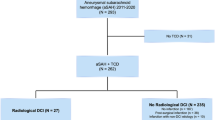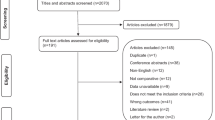Abstract
Introduction
Cerebral vasospasm (CV) is one of the most dreaded complications in patients who survive acute subarachnoid haemorrhage (SAH), and conventional cerebral angiography (DSA) is the gold standard for its diagnosis. We evaluated CT angiography (CTA) as a non-invasive alternative for diagnosis of CV and assessed if CTA could have a role in choosing appropriate treatment.
Methods
Consecutive patients with SAH and suspected vasospasm were included when DSA was performed within 24 h from CTA. Two neuro-radiologists retrospectively analysed CTA and DSA studies independently. Assessment included presence of central and peripheral vasospasm and grading of severity of central CV. A treatment recommendation based on CTA was compared to actual treatment received.
Results
Final analysis included 34 patients. CTA was more accurate for diagnosis of central then for peripheral CV with high sensitivity (reader 1, 91%; reader 2, 92%), specificity (reader 1, 73%; reader 2, 90%), accuracy, positive predictive value and negative predictive value for central vasospasm. For grading the severity of CV CTA’s sensitivity, specificity and accuracy were high for most central arteries. The reader’s recommendation of angioplasty according to CTA was significantly predictive of actual receipt of angioplasty but overestimated actual receipt of triple H treatment.
Conclusion
CTA is adequate for detecting central vasospasm in symptomatic SAH patients. A negative result should not prevent further investigation especially when evaluating arterial segments adjacent to metal artefacts from coils or clips. CTA is helpful in treatment decision making specifically regarding the need for balloon angioplasty.

Similar content being viewed by others
References
Macdonald RL, Weir B (1997) Cerebral vasospasm: prevention and treatment. In: Batjer HH, Caplan LR, Friberg L, Greenlee RG Jr, Kopitnik TA Jr, Young WL (eds) Cerebrovascular disease. Lippincott-Raven, Philadelphia, pp 1111–1121
Suarez JI, Tarr RW, Selman WR (2006) Aneurysmal subarachnoid haemorrhage. N Engl J Med 354:387–396
Kassel NF (1993) The role of vasospasm in overall outcome from aneurysmal subarachnoid haemorrhage. In: Findlay JM (ed) Cerebral vasospasm. Elsevier, Amsterdam, pp 27–28
Kassell NF, Sasaki T, Colohan AR, Nazar G (1985) Cerebral vasospasm following aneurysmal subarachnoid hemorrhage. Stroke 16:562–572
Kodama N, Mizoi K, Sakurai Y, Suzuki J (1980) Incidence and onset of vasospasm. In: Wilkins RH (ed) Cerebral arterial spasm. Williams & Wilkins, Philadelphia, pp 361–365
Awad IA, Carter P, Spetzler RF, Medina M, Williams FC Jr (1987) Clinical vasospasm after subarachnoid hemorrhage: response to hypervolemic hemodilution and arterial hypertension. Stroke 18:365–372
Shankar JJ, Dos Santos PM, Deus-Silva L, Lum C (2011) Angiographic evaluation of the effect of intra-arterial milrinone therapy in patients with vasospasm from aneurysmal subarachnoid hemorrhage. Neuroradiology 53(2):123–128
Elliott JP, Newell DW, Lam DJ, Eskridge JM, Douville CM, Le Roux PD, Lewis DH, Mayberg MR, Grady MS, Winn HR (1998) Comparison of balloon angioplasty and papavarin infusion for the treatment of vasospasm following aneurysmal subarachnoid hemorrhage. J Neurosurg 88:277–284
Terry A, Zipfel G, Milner E, Cross DT 3rd, Moran CJ, Diringer MN, Dacey RG Jr, Derdeyn CP (2006) Safety and technical efficacy of over the wire balloons for the treatment of subarachnoid hemorrhage induced cerebral vasospasm. Neurosurg Focus 21:1–7
Jun P, Ko NU, English JD, Dowd CF, Halbach VV, Higashida RT, Lawton MT, Hetts SW (2010) Endovascular treatment of medically refractory cerebral vasospasm following aneurysmal subarachnoid hemorrhage. AJNR Am J Neuroradiol 31(10):1911–1916
Suzuki S, Ito O, Sayama T, Goto K (2010) Intra-arterial colforsin daropate for the treatment of cerebral vasospasm after aneurysmal subarachnoid hemorrhage. Neuroradiology 52(9):837–845
Willinsky RA, Taylor SM, terBrugge K, Farb RI, Tomlinson G, Montanera W (2003) Neurologic complications of cerebral angiography: prospective analysis of 2,899 procedures and review of the literature. Radiology 227:522–528
Gahn G, Gerber J, Hallmeyer S, Reichmann H, von Kummer R (1999) Noninvasive assessment of the circle of Willis in cerebral ischemia: the potential of CT angiography and contrast-enhanced transcranial color-coded duplexsonography. Cerebrovasc Dis 9:290–294
Aralasmak A, Akyuz M, Ozkaynak C, Sindel T, Tuncer R (2009) CT angiography and perfusion imaging in patients with subarachnoid hemorrhage: correlation of vasospasm to perfusion abnormality. Neuroradiology 51(2):85–93
Dankbaar JW, Rijsdijk M, van der Schaaf IC, Velthuis BK, Wermer MJ, Rinkel GJ (2009) Relationship between vasospasm, cerebral perfusion, and delayed cerebral ischemia after aneurysmal subarachnoid hemorrhage. Neuroradiology 51(12):813–819
Agid R, Lee SK, Willinsky RA, Farb RI, terBrugge KG (2006) Acute subarachnoid hemorrhage: using 64-slice multidetector CT angiography to “triage” patients’ treatment. Neuroradiology 48:787–794
Westerlaan HE, Gravendeel J, Fiore D, Metzemaekers JD, Groen RJ, Mooij JJ, Oudkerk M (2007) Multislice CT angiography in the selection of patients with ruptured intracranial aneurysms suitable for clipping or coiling. Neuroradiology 49:997–1007
Schuknecht B (2007) High-concentration contrast media (HCCM) in CT angiography of the carotid system: impact on therapeutic decision making. Neuroradiology 49(Suppl 1):S15–S26
Chaudhary SR, Ko N, Dillon WP, Yu MB, Liu S, Criqui GI, Higashida RT, Smith WS, Wintermark M (2008) Prospective evaluation of multidetector-row CT angiography for the diagnosis of vasospasm following subarachnoid hemorrhage: a comparison with digital subtraction angiography. Cerebrovasc Dis 25:144–150
Goldsher D, Shreiber R, Shik V, Tavor Y, Soustiel JF (2004) Role of multisection CT angiography in the evaluation of vertebrobasilar vasospasm in patients with subarachnoid hemorrhage. AJNR Am J Neuroradiol 25:1493–1498
Takagi R, Hayashi H, Kobayashi H, Kumazaki T, Isayama K, Ikeda Y, Teramoto A (1998) Three-dimensional CT angiography of intracranial vasospasm following subarachnoid haemorrhage. Neuroradiology 40:631–635
Anderson GB, Ashforth R, Steinke DE, Findlay JM (2000) CT angiography for the detection of cerebral vasospasm in patients with acute subarachnoid hemorrhage. AJNR Am J Neuroradiol 21:1011–1015
Otawara Y, Ogasawara K, Ogawa A, Sasaki M, Takahashi K (2002) Evaluation of vasospasm after subarachnoid hemorrhage by use of multislice computed tomographic angiography. Neurosurgery 51:939–942, discussion 942–943
Yoon DY, Choi CS, Kim KH, Cho BM (2006) Multidetector-row CT angiography of cerebral vasospasm after aneurysmal subarachnoid hemorrhage: comparison of volume-rendered images and digital subtraction angiography. AJNR Am J Neuroradiol 27:370–377
Conflict of interest
We declare that we have no conflict of interest.
Author information
Authors and Affiliations
Corresponding author
Electronic supplementary material
Below is the link to the electronic supplementary material.
ESM 1
(DOC 23 kb)
Rights and permissions
About this article
Cite this article
Shankar, J.J.S., Tan, I.Y.L., Krings, T. et al. CT angiography for evaluation of cerebral vasospasm following acute subarachnoid haemorrhage. Neuroradiology 54, 197–203 (2012). https://doi.org/10.1007/s00234-011-0876-9
Received:
Accepted:
Published:
Issue Date:
DOI: https://doi.org/10.1007/s00234-011-0876-9




